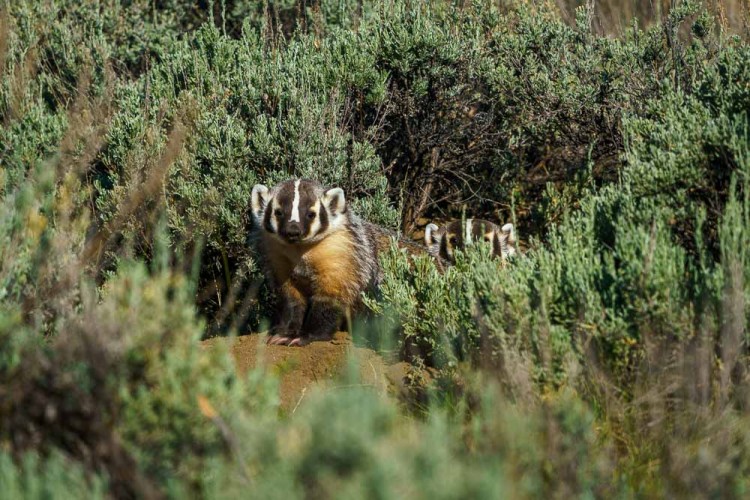July 2021 Wildlife Log

Summer is here! Baby animals have emerged across Grand Teton and Yellowstone National Parks, wildflowers are in full bloom, and highwater in rivers has subsided. Check back for updates as we enjoy exploring the diverse landscapes and wildlife of the Greater Yellowstone Ecosystem.
Beaver and Moose feeding on Willows in Grand Teton National Park
Though both are residents of riparian or wetland areas, it's rare to get a shot of a moose and a beaver in the same spotting scope view! This scene is a reminder of the important ecological role beavers play in the Greater Yellowstone Ecosystem. These large rodents are “ecosystem engineers” creating and enhancing wetland habitat through dam building. Beaver dams Stop, Slow, and Spread water to the benefit of numerous plant and animal species.
Stop - By stopping water, ponds are created, providing habitat for fish, aquatic insects, waterfowl and other species.
Slow - Terraces of beaver dams slow water and release it over the course of the dry summer months, providing a consistent source of water to the drainage down stream. This supply of water also cools streams, helping out native trout especially in drought years!
Spread - As ponds build behind dams, the water is spread out, hydrating the landscape and facilitating wetland plant growth including the willows and cottonwoods the moose and beaver are foraging on in the video. Wetland habitat is disproportionately important to wildlife, supporting dozens of songbird species in addition to numerous large mammals.
Thanks to ETA Naturalist Charlotte Catalano who was able to share this neat view with guests during a recent tour of Grand Teton National Park.
Grizzly Cub Adaptations with Naturalist Sarah Ernst
Naturalist Sarah Ernst talks about grizzly bear adaptations for raising cubs in this short from our popular Wildlife Wednesday Monthly Round up Facebook Live! Tune in the first Wednesday of each month on Facebook at 5:30pm MST to watch!
Watch the Wildlife Wednesday Monthly Round-up here.
Giant Mormon Crickets!
If you've ever noticed a massive gray insect on the trails up Cache Creek or in the sagebrush flats of Grand Teton National Park, you might just be looking at a mormon cricket (Anabrus simplex)! These giant insects are actually a type of shieldbacked katydid and can grow to 3 inches long.
Mormon crickets are harmless to people, that sharp looking stinger in the photo is called an ovipositor, and is used to lay up to 100 eggs in the soil. They are largely plant eaters but will eat other insects including other Mormon Crickets!
In most years mormon crickets are scattered throughout their preferred habitat, providing food for an assortment of birds and other animals including coyotes and foxes. However, they occasionally swarm in large numbers and can cause problems for humans. Earlier this year one of our naturalists observed massive numbers of crickets smashed on the road near Dinosaur National Monument in Colorado, so many that the road became slick! In situations like this swarms can devastate agricultural crops as well.
Fortunately swarms are rare, instead we have opportunities to enjoy this “charismatic minifauna” along with the larger species we are more accustomed to. Enjoy this short video from Naturalist Sarah Ernst about the Mormon Cricket.
Velvet Bull Elk in Grand Teton
Check out the impressive antler growth on this bull elk in Grand Teton! We're seeing peak antler growth right now, watching as velvet covered blood vessels feed bone growth of up to an inch per day!
Elk and other deer species grow a new set of antlers each year, a calorie intense investment that is tied to reproductive success. Elk with larger antlers are better able to intimidate and fight other males while attracting females during the fall mating season. There is a trade off to this strategy however, as bull elk often enter the winter in poor body condition due to their efforts and can be susceptible to starvation, exposure, or predation.
Scenes like this one remind us that the fall mating season is coming soon. Learn more about this annual September and October event here:
video by ETA Naturalist Haleigh Dunk taken from within a vehicle.















